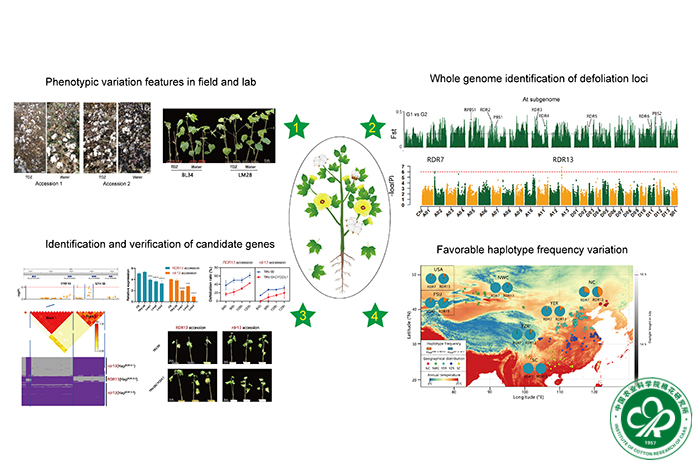- Location : Home» Newsroom
The collaboration between the Germplasm Resources and Cotton Planting Technology Standardization research teams at the Institute of Cotton Research has revealed the phenotypic and genetic variation patterns of cotton defoliation traits.
The Germplasm Resources and Cotton Planting Technology Standardization research teams at the Cotton Research Institute of the Chinese Academy of Agricultural Sciences have recently collaborated on a project. They evaluated defoliation traits across multiple environments in natural populations of upland cotton and successfully identified superior loci. This work has revealed the phenotypic variation patterns and genetic mechanisms of cotton leaf abscission, offering significant guidance for improving defoliation efficiency and breeding cultivars suited for machine harvesting.This research has uncovered the genetic mechanisms and patterns of leaf abscission in cotton. These findings have significant implications for enhancing the efficiency of cotton defoliation and breeding machine-harvested cotton varieties.An article titled 'Genomic loci associated with leaf abscission contribute to machine picking and environmental adaptability in upland cotton (Gossypium hirsutum L.)' has been recently published in the prestigious journal 'Journal of Advanced Research' (Impact Factor=12.822).
Currently, the mechanization of cotton harvesting has greatly increased in Xinjiang, which is China's primary cotton-growing region.In order to enhance the efficiency of machine-harvested cotton and minimize the amount of contaminants in seed cotton, it is essential to incorporate chemical defoliation and maturation techniques as part of the integrated agronomic practices. These techniques are critical components of cotton farming that require technical expertise for proper implementation.Despite significant efforts, there are still gaps in our understanding of the patterns of phenotypic variation and the genetic factors underlying cotton leaf abscission. Addressing these gaps is crucial for improving defoliation efficiency and developing cotton varieties that are better suited for mechanical harvesting.
This study conducted multi-environmental chemical defoliation trials on 383 upland cotton accessions, revealing the fundamental phenotypic variation in cotton defoliation traits. The use of defoliants markedly enhanced the rate of defoliation while exerting minimal impact on yield and fiber quality. A strong correlation was observed between defoliation traits with latitude and growth period characteristics. Whole-genome resequencing of the 383 upland cotton accessions (averaging a sequencing depth of 14.6X) constructed a genome-wide variation map containing 1,076,652 SNPs. Through genome-wide association study (GWAS), linkage disequilibrium (LD) block analysis, and functional identification, two genetic loci associated with the defoliation rate (RDR7 and RDR13) were identified on chromosomes A02 and A13, along with their key candidate genes GhLRR and GhCYCD3;1. The study also analyzed the combined effects and distribution frequencies of two superior haplotypes (HapRDR7 and HapRDR13). The combination of these superior haplotypes significantly increased sensitivity to defoliants. In the higher latitude regions of China, the frequency of these superior haplotypes generally increased, enabling adaptation to the local environment. It is suggested that the superior defoliation haplotypes might have originated from 'King cotton,' which was introduced early into cultivation. The corresponding authors of the paper from the Institute of Cotton Research of Chinese Academy of Agricultural Sciences, namely Du Xiongming, Song Meizhen, He Shoupu, and Zhang Xiling, who are all experts in their field of research.Li Hongge and Wang Xiangru, two Associate Researchers from the same institute, collaborated with Qin Ning, a master's student from Tarim University, to co-first author of the paper. This research was funded by the National Key Research and Development Program (2022YFD1200300), the Cotton Germplasm Resources Precision Identification Project of the Ministry of Agriculture (19221957), and the Basic Research Fund of the Institute of Cotton Research (1610162023037).
